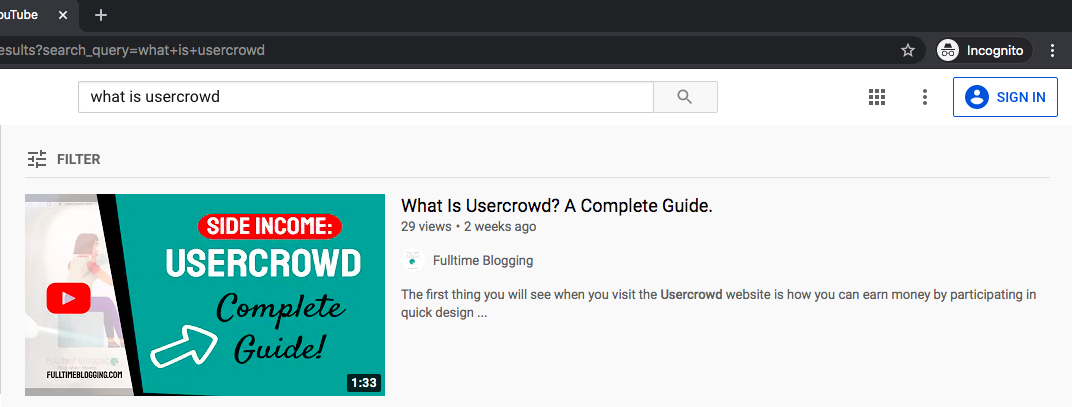Without knowing what's a long tail keyword, every content you produce will target random audiences.
Clarity. That is the first thing you need to define.
SEO gurus and training are everywhere. With too many technical things being taught, some of them neglect that there is an actual person consuming the content on the other side. That’s what I need you to focus on…
1. Focus on the person consuming your content - your target audience.
2. Focus on LONG-TAIL keywords with intent - most of the time, they have lower search volume per month, but also low competition.

Note: It's completely okay to start producing contents using your initial keywords from the previous lesson. Even if your content is only in Google Docs or if it doesn’t have SEO elements and structure yet, it’s okay.
I see people who are too concerned with keywords in their content - they end up with awkward sounding posts and awkward-looking structure.
Producing contents first will also make it easier to organize your site since you already have something to fix, instead of making a website structure out of dummy pages.
Once you have around 10 to 20 blog posts or video contents, you can start structuring your website and researching for the BEST long-tail keywords to use.
What's A Long Tail Keyword?
Long-tail keywords are simply keywords that are longer, and most of the time are with intent.
There Are Different Types Of Long-Tail Keywords With Intent:
1
They really don’t know anything about something (e.g. “What is a baby registry?”)
A person who types this long-tail keyword is probably a first-time parent, pregnant with her first baby, and was told by someone to create a baby registry. But then, she doesn’t know what it is.
Awareness. The first time parent becomes “aware” of it.
This type of long-tail keyword is usually monetized thru display Ads (the higher the number of readers/pageviews, the higher the income from ads, too). You don't have to sell anything at this stage, you just want to increase your pageviews.
2
"What to put on the baby registry?”
This type of long-tail keyword has an “intent to purchase.” The person will probably consume blog posts, YouTube videos, or Pinterest pins, that can educate her more on what to include in her “buying list.”
Intent to purchase - almost there, but not quite ready to buy yet.
This type of long-tail keyword can be used as a funnel to point your readers to some of your product reviews.
Since the "intent" to purchase is already there, you can also do some product/services mentions. Don't forget to put your affiliate links on the texts, buttons or images so you can get the proper referral credits.
3
Specific Name Product Reviews
The first time parent was told that they needed a car seat. She checks Amazon what is the best selling but she doesn’t know what to choose and what car seat to put in her baby registry.
She then uses long-tail keywords of “specific product names (model)” to learn if it’s good enough or if it is the best option.
These are usually reviews or guides of specific products/services. In order to create an income from these type of contents, you need to apply to the affiliate program of the specific product/company so you can access your affiliate links.
4
Product Comparison Reviews
The first time parent is now down to two options, Product A versus Product B. Depending on your content, this usually ends up with A PURCHASE. This is usually the stage you earn a commission.
Compared to other platforms where you need to sell a specific product/service in order to make a commission, if you point your readers to Amazon, you'll earn commissions from ANY purchase.
That's the main advantage of Amazon Affiliate Marketing.
5
"Where is the cheapest place I can get Product A?” or “Discount code for Product A” - these are the keywords some people type before they finally buy the product.
However, if you have a “coupon code” site or a website with only lists of merchants (and therefore have lots of affiliate links and zero helpful contents), it can be difficult to rank in Google.
You have to mix it with content that is useful, other than providing coupon codes.
Use your preferred paid keyword research tool (or several free tools for comparison) to find long-tail keywords that have a “question-type” feel.
People use search engines to ask questions or to learn more about something. Those are the long-tail keywords you need to produce contents about.
Another example:
Instead of targeting the “Playtestcloud” head keyword, use the long-tail keyword “is Playtestcloud legit?”
You do not know the intent of the person typing the head keyword, but you can easily produce content if you know what problem you are trying to solve (giving information to the user if Playtestcloud is indeed legit). Make sense?
By producing contents that are intended for real users (instead of gaming the system to rank in search engines), every word in your content becomes a potential keyword to rank - even the head terms!
If you are producing videos, you need to have transcriptions (I’ll teach you the fastest way to have video transcriptions in a separate lesson).
Transcriptions or the subtitles are texts that bots can crawl so they can understand more what your content is about.
Here’s how I evaluate if have a chance to rank a long-tail keyword:
- Go to Google Chrome’s incognito mode. Type your chosen long-tail keyword.
- See the top 3 organic results (not Ads). Check what they have. These are the usual elements you’ll notice.
- Clickable headline
- Long-tail keyword in the URL
- Properly-formatted readable blog posts with proper headings
- Images
- Embedded YouTube videos
- Comments
- Social shares (take note of what social media platform they are actively sharing it into)
- Internal links
- Fast loading page
- Non-intrusive ads (banners/pop-ups)
That’s it. Ignore the rest. Let backlinks (separate lessons) happen naturally.
You need to prioritize doing what the top 3 posts are doing.
Example:
My clicks from Google Search Console tells me that I am getting visitors because of the keyword “what is usercrowd.”
I investigated what the top sites have and made sure I have them, too. What they don’t have is a YouTube video, and so I created a YouTube video.
Here...top 1 in YouTube (as of grabbing this screenshot) and...

...and top 1 in Google video's search results (disclaimer: results change over time as fresher contents are produced).

To rank higher in Google, you just need to do better than those on top of you. Do it on a per content basis. That’s how you gain authority (and natural backlinks) over time.

Finding Long Tail Keywords – In 2 Minutes!
Video Transcript:
Here’s my best time-saving way of finding long-tail keywords in minutes! Go to Jaaxy Lite. It’s a free keyword research tool for all Wealthy Affiliate premium members. You can try it for free.
Now, select the alphabet soup tab. Type the long-tail keyword you want to produce content about. It is going to generate long-tail keywords from A to Z, just like when you manually do an alphabet soup technique in Google.
Once the results are loaded, select all, and save them to a list. Jaaxy Lite can only save up to 200 long-tail keywords per list. The best way to save all keywords is to break down the list into 2 or 3, just like this:
A to I, J to Q, and T until the end.
Once you have the three folders, click on view. Click on the AVG to see if there is enough search volume per month, and QSR to see how tough the competition is.
If you see that the KQI is great, it’s a good long-tail keyword to target.
Note that if you go into incognito mode and paste the exact long-tail keyword you choose to target, you will often see authority sites in the search results. Just focus on the top 3.
Investigate what they have. See what they are doing. Do they have long blog posts? Embedded YouTube video? Comments or Social shares? Is the content fresh?
If you are willing to work hard to do better than the top 3, then go ahead, use the long tail keyword. If not, it is best to find another long-tail keyword to target that has a decent search volume, low competition, and no authority sites in the top 3.
Create a free Jaaxy account here.
Jaaxy: Full FREE Training




Hello, could you give me feedback on my blog? I absolutely loved this post and I am going to consider your expertise from here on out. This is an informative post of high educational value. Thanks!
Hi Elijah,
Glad you found this lesson helpful. 🙂
I just went over your “Miracle Meditations” site (the website you placed in this comment form).
1. For the technicals, the first thing that I saw was how large your 1st image is once someone lands on your site. Google for LCP and FCP in relation to site speed. That big image on your homepage is going to drag your site down (only put it if it gives any relevance, and make sure to compress it manually before uploading or use a plugin for optimizing images).
2. You can put featured images in your blog roll. 🙂
3. Your social sharing icons on the left are a bit too much. You can focus on 3-5 social icons and then just display the more icons button for further options.
Other than that, it’s a good start! 🙂
Focus on creating more content because that’s what will bring you traffic. However, pay attention to long-tail keywords. If you want to earn faster, focus on the “buying” long-tail keywords.
Currently, I can see that your existing articles are the evergreen types – how-tos, tips…they work great when shared on Pinterest! All my evergreen content is actively shared on Pinterest. Growing a crazy amount of pageviews for evergreen content is a good backup so you can have the option to monetize your traffic thru display ads in the future if you don’t end up earning enough from affiliate marketing due to lack of product promotions (Mediavine, AdThrive, Monumetric, etc…).
Cheers,
Pitin
I find your content to be highly informative and educational. Your article helped me to identify how I have actually been using long-tail keywords this entire time. As a comprehensive guide, I can say this was an amazing checklist. Thanks!
Thank you for the kind words, and if there’s anything I can do to answer any of your questions just let me know.
I started my blog only recently, and I am in the phase of learning and gathering important information, so I am happy to read such articles that enrich my knowledge. Thanks for taking the time to write this great article about long-tail keywords!
Friendly greeting,
Nina
You’re welcome Nina! 🙂 Happy learning!